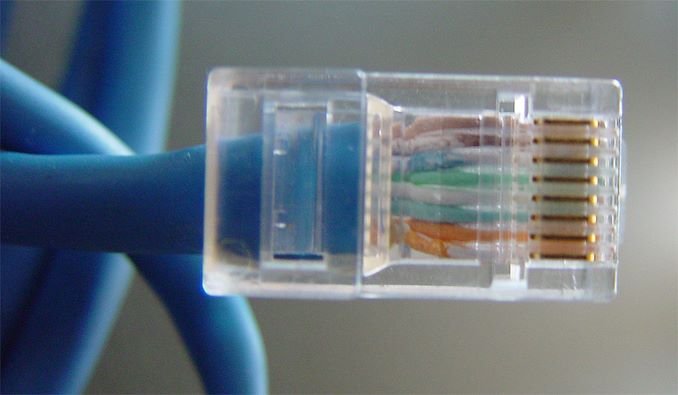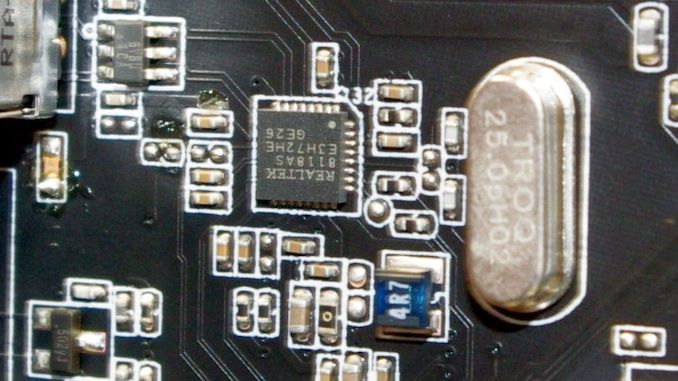Things We Missed: Realtek Has 2.5G Gaming Ethernet Controllers
by Anton Shilov on October 4, 2018 9:30 AM EST- Posted in
- Networking
- Gaming
- Realtek
- 2.5GBase-T
- Multi-Gig

Every so often, an interesting tech announcement flies under the radar, especially on the component side of matters. As it turns out, this was the case at this year's Computex trade show, where previously unbeknownst to us, Realtek introduced a new family of multi-gig Ethernet controllers. Aimed primarily at consumer devices, Realtek’s 2.5G Ethernet controllers should enable more reasonably priced and more varied multi-gig network devices.
Realtek’s lineup of 2.5G Ethernet solutions include three chips: the RTL8125 PCIe 2.0 x1 controller for PC applications; the RTL8156 USB 3.1 controller for dongles and docking applications; as well as the RTL8226 transceiver for routers and switches. All of Realtek’s 2.5GBase-T products are fully-integrated ASICs that feature a QFN package and do not require any external flash or firmware.
| Realtek's 2.5GBase-T Solutions | ||||
| Type | Interface | Applications | ||
| RTL8125 | Controller | PCIe 2.0 x1 | PCs, Embedded | |
| RTL8156 | Controller | USB 3.1 Gen 1 | Dongle, Docking | |
| RTL8226 | Physical layer transceiver | 2500BASE-X, SGMII+, USXGMII | Switches, Routers, etc. | |
Being single-chip solutions, Realtek’s 2.5G Ethernet products should allow PC and network equipment makers to build relatively affordable products supporting multi-gig speeds. And even though these are just 2.5G products, that's still a 2.5x improvement in Ethernet bandwidth, a significant jump over today's devices, which have been stuck at GigE speeds for the better part of a decade. As an aside, it's interesting to note that these are the first multi-gig controllers we've seen released that don't also support 5 Gigabit speeds. Realtek plays in the high volume/low cost space, so while we'll likely never have an answer, I'm curious as to how much they saved by not also integrating 5G support.
In any case, as far as use goes, it looks like Realtek is particularly betting on gamers for these new controllers. For several years now the company has been offering its GbE network controllers with its Realtek Dragon Software that prioritizes packets generated by games, however it has not gained a lot of traction among gamers. With its 2.5GBase-T solutions it may see more success,

Previous generation 'Dragon' Gaming 8118AS NIC from Realtek.
At the time of their June announcement, Realtek did not have any customers to announce for the new controllers. But now in October it looks like ASRock may be one of the first clients to use the RTL8125 PCIe 2.0 x1 controller, as it's a solid specification match for the company's Phantom Gaming motherboards, which are due in the coming weeks.
Overall, seeing a high volume player like Realtek enter the multi-gig Ethernet space certainly boosts our hopes for multi-gig Ethernet becoming more affordable. Even though we've seen some progress there in the last year with products such as Aquantia's controllers, multi-gig adapters and switches are still fairly expensive. With that said, however, it remains to be seen whether many consumers and small businesses will jump onboard a standard that provides only a 2.5x performance increase over existing networks.
Related Reading
- Aquantia Launch AQtion 5G/2.5G/1G Multi-Gigabit Ethernet Cards (NICs) for PCIe
- The ASRock X470 Taichi Ultimate Motherboard Review: Aquantia 10GbE on Ryzen
- ASRock Announces X299 Professional Gaming i9 with 3-Way Multi-GPU, 10Gb Ethernet, & Wi-Fi
- ASUS Launches XG-C100C 10 GBase-T Adapter: Aquantia AQC107, $99
- GIGABYTE’s GC-AQC107 10G Ethernet PCIe Card Launched and Listed
- Aquantia’s Gamer Edition AQtion AQN-107 10 GbE NIC Available
Source: Realtek










19 Comments
View All Comments
LeftSide - Thursday, October 4, 2018 - link
Are the 2.5 and 5g compatible with POE? I’m thinking the next generation of wireless APs are going to need more than 1g.thewishy - Saturday, October 6, 2018 - link
Yes, and that was one of the main use cases for multigig - APs. That said I think wired backhaul will become less common in the age of mesh.In any case, even a simple desktop to NAS filecopy has become constrained by gigabit
pixelstuff - Thursday, October 4, 2018 - link
Gamers would not have been my first guess. It seems to me that most games are designed to work well over an internet connection, and it is a minority of internet connections that are above 100 Mbps, so 1 Gbps and 2.5 Gbps would both be overkill on the bandwidth needed for gaming. Maybe you get a smallest of latency boosts in a LAN, but not likely any benefit for online gaming.The bigger usage scenario is content creators trying to shuffle their gigabyte sized video clips around the network. I just copied a 3 GB clip and it took almost 25 seconds. Dropping that down to 10 seconds would be excellent.
The bigger picture though is that 2.5 becomes the new minimum for switches and motherboards and eventually network storage is as fast as a spinning HDD. For office environments that could be a huge benefit.
Of course 10G would ultimately be best, but not if everything has to have big heat sinks everywhere to make them all work.
I sort of feel like for this to become mainstream we need to start seeing 8 and 16 port 2.5 Gbps switches with a couple 10 Gbps backbone connectors, in the $200 price range.
bcronce - Thursday, October 4, 2018 - link
I can see the CPU load now. As much as I dislike Realtek's NICs, I see this as a sign of the times as 2.5/5 Ethernet matures.But really. High end Realtek 1Gb NIC will use 70% of my CPU, making my computer stutter while the Intel NIC hangs around 0.5% and I don't even notice the 114MiB/s SMB transfer while playing video games.
WatcherCK - Thursday, October 4, 2018 - link
Wondering about Realtek's legendary OSS support... My older hardware usually ends up doing NAS or routing duties so if I pickup a board that has a realtek controller its usually a trip to aliexpress/baba for a noname intel chipset NIC.... (as a side note has anyone brought any of the 10G NICs from Ali and had good experiences with them? The price of switches continues to dampen higher than 1Gb adoption imho...)GreenReaper - Friday, October 5, 2018 - link
Looks like no in-tree driver currently uses the 2.5Gbit or 5Gbit entries added in January 2017:https://patchwork.ozlabs.org/patch/721627/
I guess we'll just have to wait for the new PHY to be added here:
https://elixir.bootlin.com/linux/latest/source/dri...
There are pictures of the USB dongle and PCIe card here:
https://pc.watch.impress.co.jp/docs/news/event/112...
brunis.dk - Friday, October 5, 2018 - link
Increasing LAN bandwidth from 1 Gb to 2,5 Gb targets gaming? Some of these marketing morons need to be punched in the face.mode_13h - Saturday, October 6, 2018 - link
I don't care how they market it, as long as people start buying so prices drop. I could use the extra bandwidth to my fileserver, but haven't been willing to pay 10 G prices.abufrejoval - Monday, October 8, 2018 - link
>1Gbit for gamers: A lot of that may just be for bragging rights, which is fine with me: If they commoditize the hardware it gets cheaper for all of us.On the other hand network speeds can be important e.g. when you run a local ARK evolved server for the loading of the world.
Other than that, I tend to get less than 500MB/s on my 10Gbit Aquantias, simply because few of the sources/sinks are capable delivering more. Sole exception being FusionIO and a NVMe unit.
I do like the idea of doing notebook backups (typically SSD) at more than 100MB/s using the USB variant.